
Hummer car cover sounds simple, but behind it is an ecosystem decision for your Hummer. Choose the wrong protection mechanism and the vehicle can age a little every day even if it barely moves. Choose correctly and the paint, glass, black plastics, chrome, and even cabin odor will be preserved through many seasons of sun and rain. With a boxy body, near-vertical glass, large wheel arches, and lots of exterior accessories, a Hummer absorbs more solar radiation than regular cars and faces wind head-on, so any cover that is not appropriate can balloon, create friction, and trap moisture. This article dives into the pain points owners often face: Should I use indoor or outdoor, do I live in a high-sun or snow-and-salt region, do I off-road frequently? From there, we unpack reasons, root causes, consequences, and remedies through the lens of physics and environment, so you can confidently choose and use a Hummer car cover as the vehicle’s second skin.
Related Articles: Hudson car cover: Scratch protection, rain beading, fast moisture release, lasting chrome shine, fewer water spots on glass
Why a Hummer needs a “correct-mechanism” car cover more than other models

A Hummer is built for harsh environments, from rough surfaces and brush to gravel, sand, mud, and unpredictable weather. Those strengths are admirable, but in daily life the very design of sharp edges, large flat planes, and upright glass makes a Hummer soak up heat, collect dust easily, and create air pockets when parked outdoors. When the sun is high, upright glass takes direct radiation and cabin temperatures rise fast. At night, surfaces hit the dew point, vapor condenses and sits at glass edges and metal trim. If the cover is airtight, moisture is squeezed between paint and fabric. If the cover is the wrong form, wind makes it inflate and deflate like a sail, turning fine dust into abrasive grit. The result is a familiar chain of symptoms: water spotting on glass, dulling and pitting on chrome, fine swirls on paint, fast fading of black plastics, and a stifling hot cabin.
The way to stop this at the source is to use a Hummer car cover that works on the right mechanisms. You want an ultra soft liner so contact is a cushioned touch, not abrasion, breathable construction so vapor can escape instead of being trapped, a beading outer finish so wet time is short after rain or morning dew, UV reflectivity to cut heat load and slow polymer aging, and a stable form so the cover stays still in wind. Whether it is a Hummer indoor cover or outdoor cover, these principles must be implemented, only the priorities differ.
Related Articles: Honda car cover: rain resistant, strong UV protection, cooler cabin, durable paint and interior
Indoor vs. outdoor, different goals and different operating mechanisms

Many people think indoor means thinner and outdoor means thicker. In fact, the two serve different goals, so they protect the vehicle differently right from fabric architecture. A Hummer indoor cover is designed for closed garages, storage facilities, and detailing studios, where the main threats are fine dust settling day by day, slow moisture emanating from concrete floors, and incidental bumps as people walk by. That is why good indoor covers emphasize a soft, smooth liner, recessed seams and soft hems, and a snug fit to eliminate micro vibration. Thanks to a soft liner and real breathability, paint does not get polished away microscopically over time and muggy odors do not linger.
By contrast, a Hummer outdoor cover faces direct sun, sudden rain, wet snow, strong wind, desert dust, and sea salt mist. Its goals are to make water bead and roll off quickly so surfaces are not held wet for long, to let vapor diffuse upward so the underside stays dry over days, to reflect UV so cabin temperatures drop, and to remain steady in the wind thanks to the form and sensible anchoring points. If indoor is the velvet suit that keeps the car clean and reduces touch friction, outdoor is the soft armor that applies the correct environmental physics. In this article we will not only name features, but also analyze why each feature is the precise answer to a specific cause and effect.
Related Articles: Hillman car cover: preserve value and extend vehicle lifespan, reduce repair and maintenance costs
When indoor is the right choice, real-world needs and storage environment
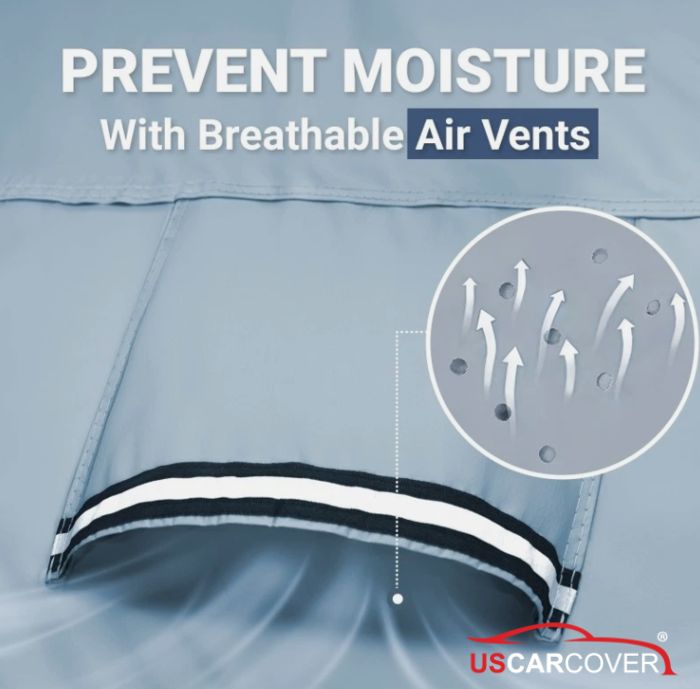
When your Hummer spends most of its time in a closed garage, the pain does not come from weather but from “slow aging”: fine dust settles evenly on large flat areas like the hood and flanks, floor moisture rises subtly from concrete, incidental bumps happen as family members walk past, and finger marks appear on paint. If the vehicle sits uncovered, every dusting is a friction event. If you cover it with thick but non-breathable fabric, trapped moisture encourages stale odors in the cabin.
In this scenario, a Hummer indoor cover with an ultra soft liner and snug fit turns every contact into a gentle touch, recessed seams and soft hems avoid leaving edge prints along glass and paint, and breathability allows surfaces to “breathe” so micro humidity is not compressed. If you have just wrapped, applied PPF, or ceramic coated, indoor protection is even more valuable because the surface is sensitive to micro friction. For long-term storage in humid regions, indoor breathability lets moisture leave gradually, breaking the “water frame” effect at glass edges and slowing chrome dulling. In short, indoor is the solution that stops subtle wear where weather is not the primary risk.
Related Articles: Graham car cover: long-term storage solution with ultra soft liner, recessed seams, and breathability
When outdoor is mandatory, climate realities and the habit of parking outside
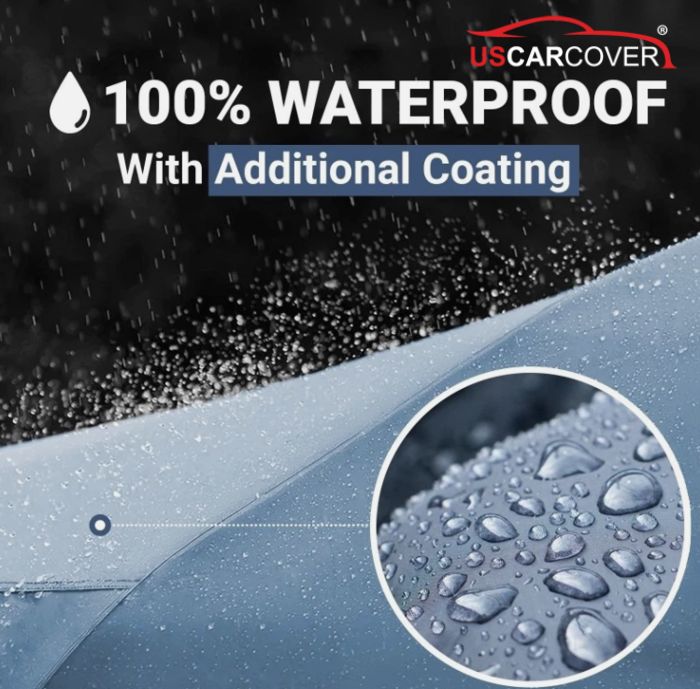
Any time you park a Hummer on the driveway, under a carport, or in open lots, or you live under difficult weather, a Hummer outdoor cover is essentially mandatory. In the Sun Belt, upright glass and large flat planes turn the cabin into a heat chamber. UV not only degrades black plastics and fender cladding, it also ages leather and interior polymers quickly. An outdoor Hummer car cover with a bright, reflective face and a breathable core reduces interior temperatures notably and prevents a humid greenhouse effect after quick showers.
In the Snow Belt, the challenge is salty wetness and road salt. When slush melts, water mixed with salt can sit on glass and trim. If the cover inflates and deflates in wind, salt particles move and rub. A Hummer outdoor cover with strong beading shortens wet time, micro-porous venting lets moisture escape, and stable anchoring keeps the cover still. At season’s end, a light rinse, full dry, and storage in a breathable bag closes the protection loop.
At the coast, a common mistake is choosing airtight fabric in the belief that tighter is safer. Airtight actually presses salty moisture onto the surface. The right answer is a breathable Hummer outdoor cover, plus the habit of lightly shaking off salt dust each time you remove it before storage. On high-wind plateaus, wind is the engine of micro vibration, so once the cover stays still, fine dust no longer acts as grit and swirl marks fade from the equation.
Finally, in tree-lined cities, sap, bird droppings, and road dust age surfaces quickly. An outdoor Hummer cover with a soft liner, beading, and real breathability that is quick to handle helps you use it every day so contaminants do not get a chance to settle.
Related Articles: How to choose a GMC car cover for Urban areas, the Sun Belt, the Snow Belt, coastal regions, and high-wind plateaus
Off-road frequency, bring mud, sand, and dust into the selection and usage plan
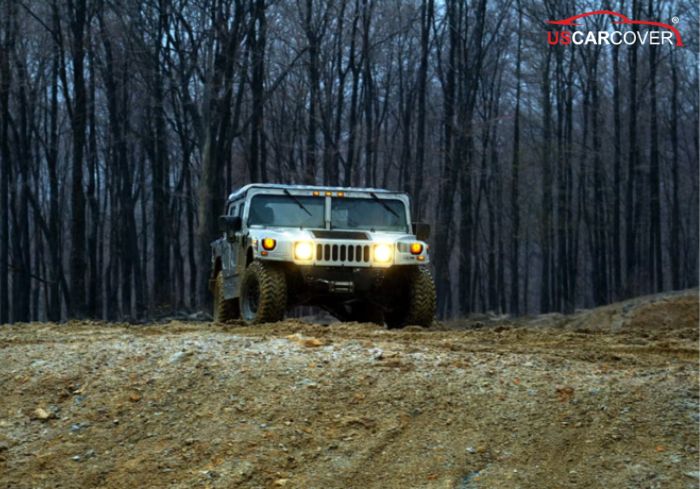
Off-road is the DNA of a Hummer, but it is also a tough exam for any outdoor Hummer car cover. When you return to base camp after a muddy or sandy run, if you cover the vehicle while large particles are still present, those dried particles become sandpaper under the fabric. The reason lies in particle size and shape, the cause is the habit of covering immediately after the trail, the consequence is dense swirls on flat panels, and the remedy is changing your rhythm to brush off debris, let it flash-dry, then cover. Therefore, prioritize an outdoor Hummer cover that is easy to shake and dry, breathable so remaining damp mud is not trapped, and lined with a soft fabric that resists pilling and dye bleed when damp. For Hummer EVs with removable roof panels and glass roof, the pattern should allow for roof features and hug the edges to keep fine dust from wicking into seals, while a reflective outer face helps protect the glass panel and reduce interior heat in midday sun.
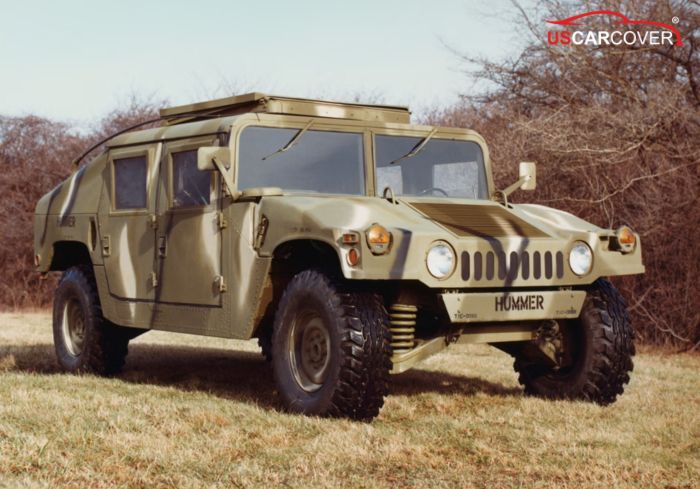
Related Articles: Geo car cover: reduce maintenance, protect 90s dashboards and plastics, and preserve resale value
Typical pain points and how a Hummer car cover stops the damage at its source

Cabin heat and fading black plastics: the root cause is UV and thermal load hitting upright glass and the hood. High heat accelerates aging in plastics, leather, and seals, creating sharp odors. A bright, reflective Hummer outdoor cover lowers heat immediately, and a UV-resistant system keeps black plastics and cladding richer in color so interiors age more slowly.
Water spots and white frames at glass edges: the culprit is condensation sitting at curved edges for long hours. A beading surface releases droplets quickly, a breathable core avoids pressing moisture from below, and recessed seams with soft hems prevent hard-edge loading on the glass. By cutting the chain of causes, you reduce the need for heavy de-spotting chemicals.
Dulling chrome and pinpoint pitting: on the coast or in the Snow Belt, salty moisture pressed against chrome triggers localized corrosion. A Hummer outdoor cover that both beads water to shorten wet time and breathes to avoid salty greenhouse conditions, while staying still in the wind, prevents salt rubbing. Each removal, a light shake ejects salt dust from the fabric, which completes the protection loop.
Fine swirls on large panels: this is micro vibration plus fine dust. When a Hummer cover stays still, the soft liner turns contact into a gentle touch and swirls lose their growth path. This is why a correct form or custom-fit approach is worth the investment compared with generic sizing.
Mud and sand after off-road: the problem is not the fabric, it is the habit. Adding 60 to 90 seconds to brush off large particles and flash-dry before covering eliminates most risk.
Related Articles: Genesis car cover: extend vehicle lifespan by blocking dust, leaves, UV, and heavy rain
Choose by U.S. climate, turn where you live into clear buying criteria
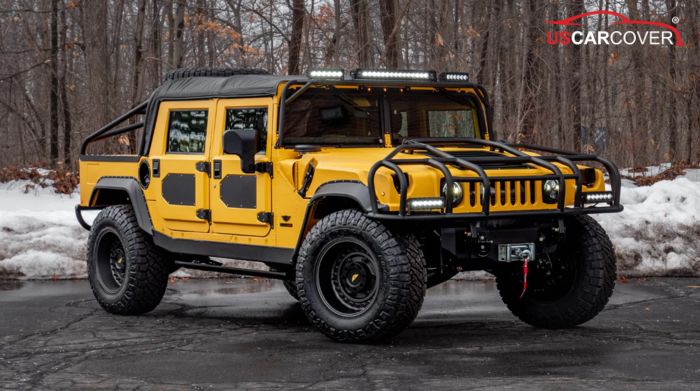
In the Sun Belt, such as Arizona, Nevada, Texas, and Southern California, focus on UV-resistant Hummer outdoor covers with bright, reflective faces and real breathability. For short midday parking in open lots, a half cover that shields glass and roof can drop cabin temperatures quickly, while a full cover remains the choice for overnight.
In the Snow Belt, such as Michigan, Minnesota, Wisconsin, and New York, choose an outdoor Hummer cover with strong beading and stable anchoring so it stays still. At season’s end, rinse lightly, dry fully, and store for durable reuse.
Along the coast, prioritize breathability. Any airtight material will backfire by trapping salty moisture. Each time you remove the cover, shake off salt dust before storage.
On high-wind plateaus in the High Plains and Rockies, pay attention to wind stability and to recessed seams and soft hems so edges do not print onto glass.
In tree-lined urban areas like Northern California or the Northeast suburbs, the key is habit. A Hummer cover that is quick to deploy and remove will make daily use natural, blocking sap, droppings, and fine dust at the door.
Common misconceptions when choosing a Hummer car cover, and why to drop them
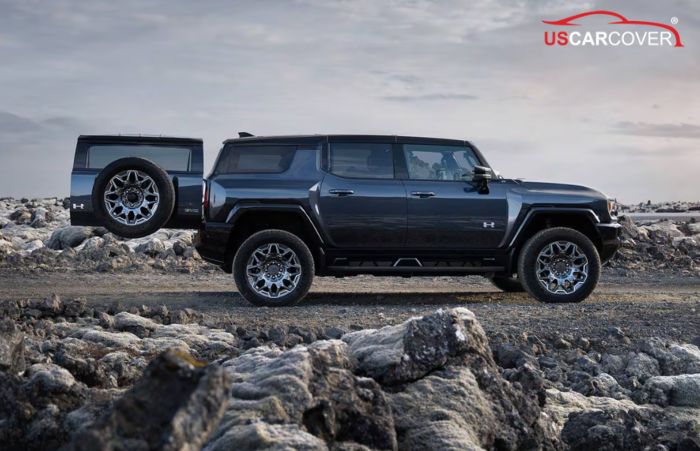
“Thicker is always better.” Thickness is only one variable. Thick but airtight is a recipe for odors and glass edge rings. What determines effectiveness is the mechanism, beading to shorten wet time, breathability to let vapor out naturally, a soft liner to protect paint, and a steady form to eliminate micro vibration.
“Indoor can double outdoors for a while.” Possibly for a few hours of fair weather. Overnight it will trap moisture. Once the vehicle is outdoors, use a proper Hummer outdoor cover so the underside stays dry over days, not dry for a few hours and damp again.
“Generic sizing is fine.” With a large body and upright glass, generic covers rarely stay still. When a cover inflates and deflates, fine dust becomes abrasive grit. A correct form or custom-fit Hummer cover delivers superior paint safety.
“Any cover is enough, habits do not matter.” Habits drive most of the results. Standardize the rhythm of brush off, flash-dry, and cover, then dry and store in a breathable bag, and you have doubled the value of the cover.
Where to buy a Hummer car cover to “get it right the first time”
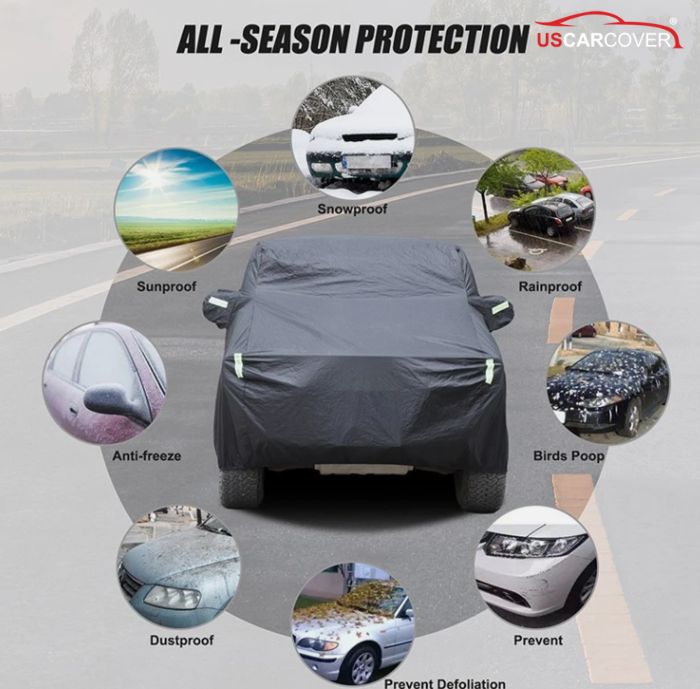
A cover only has value when you want to and can use it every day. That comes from a seller who understands U.S. climate, your parking habits, and your off-road frequency, and who provides the correct Hummer configuration for indoor or outdoor use. Look for clear explanations of how beading, breathability, soft liners, recessed seams, and stable form work together, and advice tailored to the Sun Belt, Snow Belt, coastal, and high-wind regions, plus your driveway, carport, or open-lot routine. Once the form is right, the liner soft enough, the core breathing, and the outer face reflective, each install and removal is quick, tidy, and clean, habits form naturally, and protection compounding starts day by day. If you want a friendly place to start where you can look up by model year and usage context, US Car Cover is a solid choice to get the first step right.
Usage habits, make the cover your Hummer’s second skin
A good Hummer car cover is useless if you feel it is a chore. The secret is to make it the quick, clean last step of the day. When you stop, spend half a minute brushing off large particles on the hood, glass, and flanks. If the vehicle is wet, let the surface flash-dry, then place the cover along the natural fall of the fabric. Secure just enough so the cover stays still in the wind. In the morning, lift and fold neatly. If the cover is still damp, dry it fully before storing it in a breathable bag. After a few weeks, you will see the aging curve slow down, fewer water spots on glass, deeper chrome luster, longer-lasting black plastics, smoother paint with fewer swirls, and a cabin free of harsh odors under the sun. This is how to get maximum value from a rain-resistant, UV-resistant, soft-lined, heat-reducing Hummer cover with a very everyday routine.
Choose the right type, use it in the right place, and protect with the right mechanism

The indoor or outdoor question is really how you define a Hummer cover for your situation. Indoor keeps the car clean, reduces touch friction, and breathes well in closed garages. Outdoor blocks sun, rain, wind, and salt for driveways, carports, and open lots. Either way, make sure the four pillars are present, beading to shorten wet time, breathability so moisture is not trapped, a soft liner to protect paint, and UV reflectivity to cut cabin heat. When you turn a Hummer cover into a habit, your vehicle will age much more slowly, glass shows fewer rings, chrome shines longer, black plastics hold their color, paint stays smoother, and the interior remains pleasant. It is a small investment that makes a big difference through seasons of sun, wind, rain, dust, and those long days you take your Hummer far from home.
